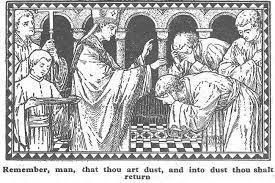Ash Wednesday 2021: Why Ashes Will Be Sprinkled
Feb 16, 2021 by Rachel Summa
Like every holy day since the beginning of COVID-19, Ash Wednesday 2021 will look a bit different.
Ash Wednesday marks the beginning of Lent. If you attend Mass in the United States that day, you traditionally receive a cross of ashes on your forehead, while the priest speaks words from Genesis 3:19: “Remember that you are dust, and to dust you shall return.” These ashes remind us that life on earth is temporary. We were made from nothing, and will return to dust at our death.
For the rest of the day, we walk around with black smudges on our foreheads, and may find ourselves bothered or amused by the strange looks and questions we receive. Ash Wednesday is always a great witness to our faith and a reminder to those around us of our mortality and of Christ’s sacrifice for us.
Read more: How To Explain Your Ashes
Last year, Ash Wednesday was the last “normal” Catholic holy day for us. It was only a few weeks later that the World Health Organization declared coronavirus a pandemic and President Donald Trump declared a National Emergency in the United States.
Depending on the diocese, we had to go weeks or even months without attending Mass in-person. Now most churches are once again offering the Holy Sacrifice of the Mass, but with blocked off pews, hymnals removed, and other precautions.
Following these changes in the celebration of the Mass, the Vatican released some guidelines for this year's celebration of Ash Wednesday. Instead of directly touching the forehead with ashes, priests are asked to bless the ashes and recite to the congregation, “Remember that you are dust, and to dust you shall return.” Members of the congregation will come up to the altar and the priest will sprinkle ashes on each person’s head, to eliminate direct contact.

Upon reading this, many of us may have wondered: “Why are we doing it this way on Ash Wednesday? Is this an acceptable substitution for the cross on our forehead?”
In the United States, this procedure seems strange, and we are disappointed that Ash Wednesday will not be the same. However, this way of distributing ashes is legitimate and does follow tradition.
Sprinkling ashes on the head goes all the way back to the Old Testament, when the people of Israel would put on sackcloth and ashes as a sign of penance. For example, Nehemiah 9:1 reads:
“On the twenty-fourth day of this month, the Israelites gathered together while fasting and wearing sackcloth, their heads covered with dust.”
In the early Church, Christians who committed grave sins would participate in a public confession which included having ashes sprinkled on their heads. While this specific use of the sprinkling of ashes is no longer practiced, Catholic churches in Europe and beyond, especially in Italy and Poland, still commemorate Ash Wednesday with this sprinkling today.
While this year's Ash Wednesday Mass may look different, rest assured that the change from a cross of ashes to a sprinkling of ashes does not abandon sacred tradition. We will simply be following a different tradition, one that is still Biblical and one that many of our Catholic brothers and sisters in Europe and around the world have already been practicing.
[[3551, 22744]]
Have you ever received ashes in the sprinkling form? Is this the first time you've ever heard of it? Share your thoughts in the comments below!




